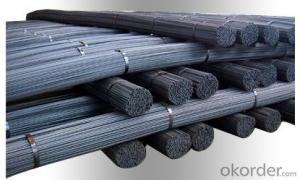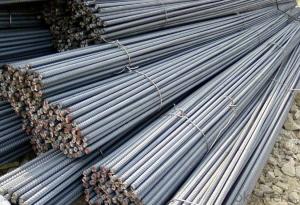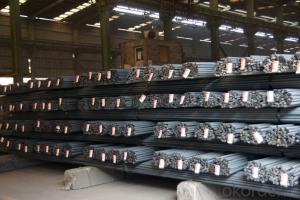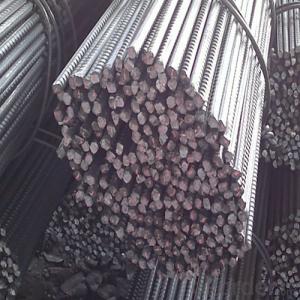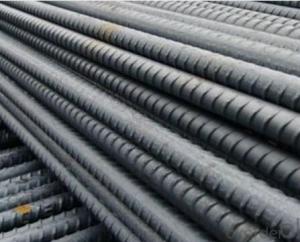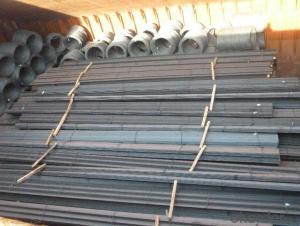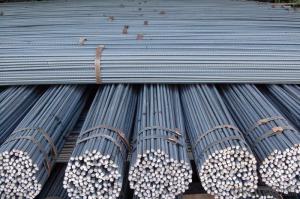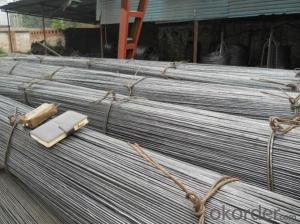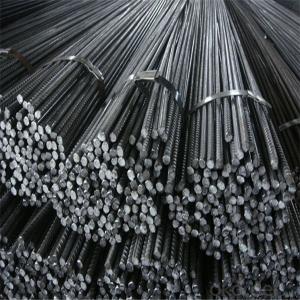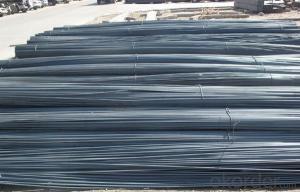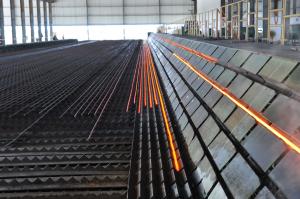B500A deformed steel bar deformed steel bar
- Loading Port:
- Tianjin
- Payment Terms:
- TT or LC
- Min Order Qty:
- 25 m.t.
- Supply Capability:
- 100000 m.t./month
OKorder Service Pledge
OKorder Financial Service
You Might Also Like
Product Description:
OKorder is offering B500A deformed steel bar at great prices with worldwide shipping. Our supplier is a world-class manufacturer of steel, with our products utilized the world over. OKorder annually supplies products to European, North American and Asian markets. We provide quotations within 24 hours of receiving an inquiry and guarantee competitive prices.
Product Applications:
B500A deformed steel bar are ideal for structural applications and are widely used in the construction of buildings and bridges, and the manufacturing, petrochemical, and transportation industries.
Product Advantages:
OKorder's deformed steel bar are durable, strong, and resist corrosion.
Main Product Features:
· Premium quality
· Prompt delivery & seaworthy packing (30 days after receiving deposit)
· Corrosion resistance
· Can be recycled and reused
· Mill test certification
· Professional Service
· Competitive pricing
Product Specifications:
Specifications of HRB400 Deformed Steel Bar:
Standard | GB | HRB400 | |
Diameter | 6mm,8mm,10mm,12mm,14mm,16mm,18mm,20mm, 22mm,25mm,28mm,32mm,36mm,40mm,50mm | ||
Length | 6M, 9M,12M or as required | ||
Place of origin | Hebei, China mainland | ||
Advantages | exact size, regular package, chemical and mechanical properties are stable. | ||
Type | Hot rolled deformed steel bar | ||
Brand name | DRAGON | ||
Chemical Composition: (Please kindly find our chemistry of our material based on HRB500 as below for your information)
Grade | Technical data of the original chemical composition (%) | ||||||
C | Mn | Si | S | P | V | ||
HRB400 | ≤0.25 | ≤1.60 | ≤0.80 | ≤0.045 | ≤0.045 | 0.04-0.12 | |
Physical capability | |||||||
Yield Strength (N/cm²) | Tensile Strength (N/cm²) | Elongation (%) | |||||
≥400 | ≥570 | ≥14 | |||||
Theoretical weight and section area of each diameter as below for your information:
Diameter(mm) | Section area (mm²) | Mass(kg/m) | Weight of 12m bar(kg) |
6 | 28.27 | 0.222 | 2.664 |
8 | 50.27 | 0.395 | 4.74 |
10 | 78.54 | 0.617 | 7.404 |
12 | 113.1 | 0.888 | 10.656 |
14 | 153.9 | 1.21 | 14.52 |
16 | 201.1 | 1.58 | 18.96 |
18 | 254.5 | 2.00 | 24 |
20 | 314.2 | 2.47 | 29.64 |
22 | 380.1 | 2.98 | 35.76 |
25 | 490.9 | 3.85 | 46.2 |
28 | 615.8 | 4.83 | 57.96 |
32 | 804.2 | 6.31 | 75.72 |
36 | 1018 | 7.99 | 98.88 |
40 | 1257 | 9.87 | 118.44 |
50 | 1964 | 15.42 | 185.04 |
Usage and Applications of HRB400 Deformed Steel Bar:
Deformed bar is widely used in buildings, bridges, roads and other engineering construction. Big to highways, railways, bridges, culverts, tunnels, public facilities such as flood control, dam, small to housing construction, beam, column, wall and the foundation of the plate, deformed bar is an integral structure material. With the development of world economy and the vigorous development of infrastructure construction, real estate, the demand for deformed bar will be larger and larger..
Packaging & Delivery of HRB400 Deformed Steel Bar:
Packaging Detail: products are packed in bundle and then shipped by container or bulk vessel, deformed bar is usually naked strapping delivery, when storing, please pay attention to moisture proof. The performance of rust will produce adverse effect.
Each bundle weight: 2-3MT, or as required
Payment term: TT or L/C
Delivery Detail: within 45 days after received advanced payment or LC.
Label: to be specified by customer, generally, each bundle has 1-2 labels
Trade terms: FOB, CFR, CIF
Deformed Steel Bar in container
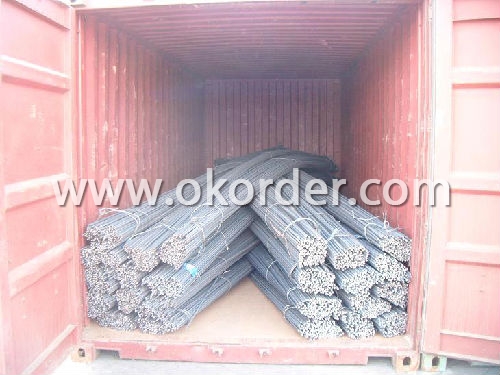
Deformed Steel Bar in factory
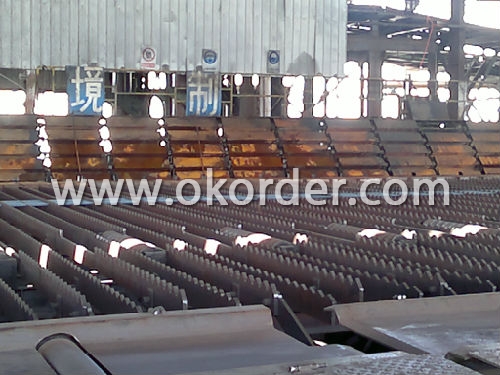
Note:
1. Our products are produced according to national standard (GB), if not, supply according to national standards (GB) or agreement as customer required.
2. Other Grade and Standard Deformed Steel Bar we can supply:
Grade: GR40/GR60, G460B/B500A/B500B/B500C,BST500S
Standard: ASTM, BS, DIN
The Minimum Order Quantity of these products is high, and need to be confirmed.
3. We can not only supply Deformed Steel Bar; if you need anything about building materials, please contact us for further information.
4. Please send us your detail specifications when inquire. We will reply to you as soon as possible. We sincerely hope we can establish a long stable business relationship.
FAQ:
Q1: How do we guarantee the quality of our products?
A1: We have established an advanced quality management system which conducts strict quality tests at every step, from raw materials to the final product. At the same time, we provide extensive follow-up service assurances as required.
Q2: What makes stainless steel stainless?
A2: Stainless steel must contain at least 10.5 % chromium. It is this element that reacts with the oxygen in the air to form a complex chrome-oxide surface layer that is invisible but strong enough to prevent further oxygen from "staining" (rusting) the surface. Higher levels of chromium and the addition of other alloying elements such as nickel and molybdenum enhance this surface layer and improve the corrosion resistance of the stainless material.
- Q: Are steel rebars suitable for use in road construction?
- Yes, steel rebars are suitable for use in road construction. They provide strength and durability to the concrete used in road structures, enhancing their load-bearing capacity and resistance to cracking or breaking under heavy traffic loads. Steel rebars also help in reinforcing the pavement to ensure its longevity and structural integrity.
- Q: What are the guidelines for proper handling and disposal of steel rebars on construction sites?
- Here are the revised guidelines for the correct handling and disposal of steel rebars on construction sites: 1. Handling: - It is important to wear the appropriate personal protective equipment (PPE) such as gloves and safety glasses when handling steel rebars. - To prevent injuries, make sure to lift and carry the rebars correctly, using your legs and not your back. - Avoid throwing or dropping rebars as this can cause damage to the surrounding area and potentially harm workers. 2. Storage: - Rebars should be stored in a designated area that is easily accessible and away from traffic or other hazards. - To prevent them from rolling or falling, stack the rebars vertically. - Organize the rebars using racks or shelves to avoid tangling or damage. 3. Disposal: - Properly dispose of damaged or unusable rebars. - Contact local waste management authorities to understand the specific disposal requirements for steel rebars in your area. - Consider sending the rebars to a recycling facility if recycling is available, to reduce waste and promote sustainability. - Avoid disposing of steel rebars in regular trash bins or open areas, as they can be a safety hazard. 4. Transportation: - When moving rebars within the construction site or transporting them to another location, ensure they are properly secured to prevent falling off the vehicle or causing damage. - Use appropriate vehicles, such as trucks or trailers, with sufficient tie-down points for proper transportation. 5. Training and Communication: - Ensure that all workers involved in handling and disposing of steel rebars receive adequate training on the guidelines and safety procedures. - Clearly communicate the guidelines to all workers, including subcontractors or temporary workers, to ensure consistent adherence to the rules. - Regularly review and update the guidelines as needed to address any evolving safety concerns or regulatory changes. By adhering to these guidelines, construction sites can create a safe and organized working environment while ensuring the proper handling and disposal of steel rebars.
- Q: How are steel rebars protected from corrosion in marine environments?
- Steel rebars are protected from corrosion in marine environments through the application of a protective coating, such as epoxy or zinc, or by using stainless steel rebars that have inherent resistance to corrosion. Additionally, concrete cover is provided to rebars to isolate them from direct contact with seawater, further enhancing their protection against corrosion.
- Q: What is the role of steel rebars in earthquake-resistant building design?
- The role of steel rebars in earthquake-resistant building design is to provide reinforcement and strength to the structure. Rebars help absorb and distribute the energy generated during an earthquake, reducing the risk of structural failure and damage. They enhance the building's ability to withstand the lateral forces and vibrations caused by seismic activity, making it more resilient and safer for occupants.
- Q: Are there any standards or codes for steel rebars?
- Yes, there are various standards and codes that govern the manufacturing, testing, and use of steel rebars. These standards typically include specifications for the chemical composition, mechanical properties, dimensions, and tolerances of rebars. Some commonly recognized standards and codes for steel rebars include ASTM A615/A615M, ASTM A706/A706M, and BS 4449. Compliance with these standards ensures the quality and safety of steel rebars used in construction projects.
- Q: How do steel rebars affect the overall cost of maintenance?
- Steel rebars can significantly affect the overall cost of maintenance in several ways. Firstly, the quality and durability of steel rebars play a crucial role in ensuring the structural integrity of buildings and infrastructure. When steel rebars are of high quality and properly installed, they can enhance the strength and longevity of concrete structures, reducing the need for frequent repairs or replacements. This, in turn, lowers the maintenance costs over time. Additionally, steel rebars provide reinforcement to concrete, making structures more resistant to external forces such as seismic activities, heavy loads, and environmental factors like corrosion. By increasing the structural resilience, steel rebars can minimize the likelihood of damage and the subsequent maintenance expenses that would be required to fix or restore the affected areas. Moreover, proper maintenance of steel rebars themselves is essential to prevent corrosion. Without adequate preventive measures like regular inspections, cleaning, and applying protective coatings, rebars can succumb to rust and corrosion, ultimately compromising the structural integrity of the entire concrete structure. Corrosion-related repairs or replacements can be extremely costly and time-consuming, significantly impacting the overall maintenance budget. Lastly, the choice of steel rebars during the construction or renovation phase can also influence maintenance costs. Opting for higher-grade rebars with superior corrosion resistance can initially increase the upfront costs but can substantially reduce the long-term maintenance expenses. Investing in high-quality steel rebars can minimize the need for frequent repairs and replacements, resulting in overall cost savings and improved structural reliability. In conclusion, steel rebars have a direct impact on the overall cost of maintenance. By providing reinforcement and enhancing structural integrity, high-quality rebars can reduce the need for repairs, prevent damage, and improve the durability of concrete structures. However, neglecting proper maintenance of rebars can lead to corrosion issues, which can be expensive to address. Therefore, careful consideration of the quality, installation, and ongoing maintenance of steel rebars is essential to minimize maintenance costs in the long run.
- Q: What are the guidelines for proper curing of concrete structures with steel rebars?
- Proper curing of concrete structures with steel rebars is essential to ensure their strength, durability, and longevity. Here are some guidelines to follow for the proper curing of such structures: 1. Moisture Control: During the curing process, it is crucial to maintain a moist environment around the concrete structure. This can be achieved by covering the surface of the concrete with a plastic sheet or using a curing compound. This helps to prevent the evaporation of water from the concrete, which can lead to shrinkage, cracking, and reduced strength. 2. Duration of Curing: The duration of curing depends on various factors such as the type of concrete mix, environmental conditions, and the size and complexity of the structure. Generally, curing should continue for a minimum of 7 days to allow the concrete to gain sufficient strength. However, for structures with steel rebars, it is recommended to extend the curing period to 14-28 days to ensure proper hydration and bonding between the concrete and steel. 3. Temperature Control: Temperature plays a vital role in the curing process. It is important to avoid extreme temperature fluctuations during curing, as they can negatively impact the strength and durability of the concrete. If the temperature is too high, it may cause rapid drying and shrinkage, leading to cracks. On the other hand, freezing temperatures can impede proper hydration. Therefore, maintaining a moderate and consistent temperature is crucial for effective curing. 4. Protection from External Factors: During the curing period, the concrete structure should be protected from external factors that can harm its integrity. This includes preventing the structure from being exposed to direct sunlight, rain, strong winds, or any other adverse weather conditions. Additionally, it is essential to protect the concrete from any potential damage caused by construction activities or heavy loads during the curing process. 5. Regular Inspection and Maintenance: Regular inspection of the concrete structure during the curing process is necessary to identify any potential issues such as cracks, honeycombing, or inadequate curing. Any such issues should be addressed promptly to prevent further damage. Additionally, once the curing process is complete, it is important to implement a proper maintenance plan to ensure the long-term durability and structural integrity of the concrete structure. By following these guidelines, proper curing of concrete structures with steel rebars can be achieved, resulting in strong, durable, and reliable construction.
- Q: Can steel rebars be used in swimming pool construction?
- Yes, steel rebars can be used in swimming pool construction. They are often used as reinforcement in the concrete structure of the pool to provide strength and durability. The rebars help to prevent cracking and ensure the pool can withstand the pressure of the water.
- Q: How do steel rebars impact the overall flexibility of a structure?
- Steel rebars, also known as reinforcing bars, play a crucial role in enhancing the overall flexibility of a structure. These bars are typically used in reinforced concrete structures to provide tensile strength and improve the structural integrity of the building. The incorporation of steel rebars in concrete significantly increases the flexibility of a structure. Concrete itself is strong in compression but weak in tension. By integrating rebars, the structure becomes more capable of withstanding tensile forces and resisting bending or deformation caused by external loads or environmental factors. The rebars act as reinforcement by absorbing and distributing tensile forces throughout the structure, helping to prevent cracks and ensuring a more even distribution of stress. This is particularly important in areas prone to seismic activity or high wind loads, where structures need to be able to flex and absorb the energy exerted on them. Moreover, the presence of steel rebars also allows for the creation of thinner and lighter concrete sections. This contributes to the overall flexibility of the structure by reducing the dead load, making it more responsive and adaptable to different conditions. In summary, steel rebars greatly impact the overall flexibility of a structure by providing tensile strength, preventing cracks, distributing stress, and allowing for lighter and thinner concrete sections. By enhancing the structural integrity and resilience, the inclusion of rebars ensures that the building can withstand external forces while maintaining its stability and flexibility, ultimately contributing to its longevity and safety.
- Q: What are the guidelines for the proper anchoring of steel rebars in columns?
- To guarantee the structural integrity and safety of reinforced concrete structures, it is crucial to adhere to guidelines regarding the appropriate anchoring of steel rebars in columns. These guidelines are typically established based on industry standards and codes, such as the American Concrete Institute (ACI) Building Code Requirements for Structural Concrete (ACI 318). 1. Lap Length: For sufficient bond strength, rebars must overlap by a minimum distance known as the lap length. This length is determined considering factors like rebar diameter, grade, concrete strength, and design requirements. To calculate the required lap length, specific formulas and tables provided by ACI 318 are used. 2. Embedment Length: The embedment length refers to the section of the rebar embedded within the concrete column. Achieving adequate embedment is essential to effectively transfer applied loads. The embedment length is determined based on factors such as rebar diameter, grade, and compressive strength of concrete. 3. Development Length: The development length is the minimum length of rebar needed beyond the critical section to fully develop its tensile or compressive strength. This ensures the rebar can withstand applied loads and avoid premature failure. ACI 318 provides formulas to calculate the development length considering rebar diameter, grade, concrete strength, and design requirements. 4. Concrete Cover: Concrete cover refers to the thickness of concrete between the rebar's external surface and the column's outer surface. It provides protection against corrosion, fire, and environmental factors. The required concrete cover is determined by considering factors like rebar diameter, grade, exposure conditions, and design requirements. ACI 318 provides minimum cover requirements for different rebar sizes and exposure conditions. 5. Spacing and Positioning: Proper spacing and positioning of rebars within the column are crucial to ensure uniform load distribution and effective reinforcement. The spacing is determined based on column dimensions, rebar diameter, and design requirements. Additionally, rebars should be properly aligned and centered within the column to achieve the intended structural strength. 6. Mechanical Anchorage: In certain cases, mechanical anchorage devices like rebar couplers or headed bars are employed to enhance rebar anchoring in columns. These devices improve load transfer and prevent rebar slippage. The selection and installation of mechanical anchorage should adhere to the manufacturer's recommendations and relevant standards. 7. Quality Control and Inspection: Implementing proper quality control and inspection procedures during rebar installation in columns is crucial. This involves verifying dimensions, lap lengths, embedment lengths, development lengths, concrete cover, spacing, and positioning of the rebars. Regular inspections and non-destructive testing techniques such as ultrasonic or radiographic testing can be utilized to ensure compliance with guidelines and identify any defects or deviations. It is important to note that these guidelines may vary based on specific design requirements, local building codes, and structural considerations. Therefore, it is recommended to consult relevant standards and seek professional advice from structural engineers or experts to ensure proper anchoring of steel rebars in columns.
Send your message to us
B500A deformed steel bar deformed steel bar
- Loading Port:
- Tianjin
- Payment Terms:
- TT or LC
- Min Order Qty:
- 25 m.t.
- Supply Capability:
- 100000 m.t./month
OKorder Service Pledge
OKorder Financial Service
Similar products
Hot products
Hot Searches
Related keywords
